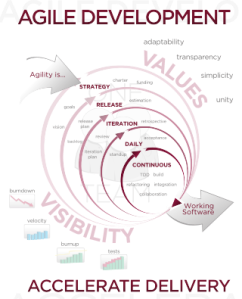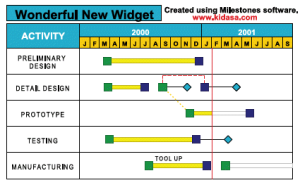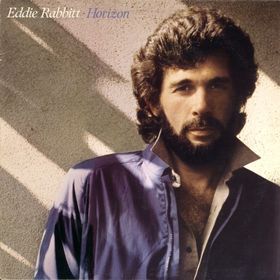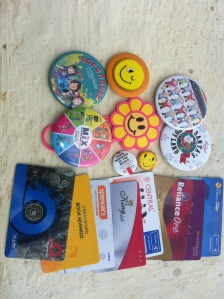
A big influence on me growing up was Ayn Rand – (I just realized that my husband spent his youth reading/ talking and believing in largely left oriented – socialistic stuff, and I reading/ talking/ believing in Ayn Rand! This may have been an offshoot of city vs. small town living, or natural proclivities to one side or the other during the cold war! but, still point to ponder at the next marital discord session!. However, I’m getting sidetracked here – let me get back to the point!)
One of the scenes that stayed in my mind was when Dominique asks Howard Roark if his life was more a series of “stops” i.e., did he just live everyday in a “continuous” stream, or kind of progress from one point to another in “discrete” intervals. I forget what the point of that question/ and the context behind it was, (I tried googling and found many “quotable quotes” from Fountainhead, but not this one – I should borrow it from the library and see what my adult self thinks of my youth-time obsession – but, if I run true to Rand’s philosophy, then “There’s so much nonsense about the human inconstancy and the transience of all emotions. I’ve always thought that a feeling which changes never existed in the first place. There are books I liked at the age of sixteen. I still like them.”).
But, again, to get back to the point – that scene I do often remember, coz that’s certainly the way I live. You have a fairly humdrum life in general – getting more and more routine and frustrating everyday, – as little peccadilloes keep piling up and irritating the hell out of you. But what makes you survive is those “golden moments” that you keep looking forward to. So, it’s the next nice lunch with your friends that you havn’t met for a while, or the great concert you are going to, or the next time you complete a new algorithm; or the time when you close a deal…small milestones achieved, leading to rewards…
Its kind of like my friend Shoma, who “signs up” herself and her family for every single class going – mind reading, guitar, drama, robotics, tennis, dance, yoga, basketball, ….- as long as that class has exams to pass! So a lot of time on her weekly schedule consists of going to Lamda/ Gandharva Mahavidyalaya/ U-14 play offs – blah blah blah.
I have to confess the greatest kick I used to get out of one of my kids’ classes was the martial arts one. That guy had his business model down pat – charge for the monthly class, but every 2 – 3 months hold a “belt test”. This was held early in the morning in a school far off from home – there were excited kids of all ages dressed in the traditional white whats-it-called dress, sleepy eyed parents, the master – and many coloured belts! After an hour of waiting, there would be a 10 minute “test” (euphemism for vague arm waving by kids en masse), and then the “belt award ceremony” – where each child got a belt of the next higher color. Incidentally, for each belt test – you coughed up more money (this belt test fees increased in correlation with order of belts!) Fantastic, wasn’t it? But it’s understandable – as someone once told me, you put me in a masters program, I’ll do really well. Put me in a PhD – I wont ever make it! Translated, most of us react well when we have achievable goals, and then opportunity to celebrate those goals, in front of us. So, discrete movements – not continuous stream 🙂
I’m often asked about running a company – when did we make a business plan (answer – never really till we were selling it off!); how did we set our vision (answer – my partner Debjani just “set it down” one day as we needed one for the website); how did we decide we wanted to move onto the social media space (anwer: we didn’t really, we were using existing data for research, it so happened that Social Media started becoming bigger – we were in right place at right time, so hopped onto the bandwagon…) (you may remember from my post, entrepreneurship was pretty much “thrust upon us”). But, allied to vision, is the issue of “goals” – and that I think we took a pragmatic view of. While we did have the grand “end vision” of making the next Google (we wanted to be the B2B search engine – ie, you need a business question answered – we will answer it for you – from EXISTING data!); but in everday life, we really set ourselves small goals – baby steps. There’s a lot to be said for that – it makes sure you set yourselves enough challenges, and yet award yourself the chance to feel happy/ fulfilled and therefore motivated when you achieve that goal. As life is all about moving forward, you then repeat the cycle by setting another set of baby goals, and then go bust to deliver that, reward yourself and others when it’s done – repeat cycle again and again.

Though I’m not a software person, I think this is what the “agile” development methodology is about – break up the task into smaller pieces, gives you an opportunity to control better, align with client’s objectives better, showcase progress to client better, and course-correct if required – also gives you goals that you can “see” – that you can work towards – and therefore, maybe, work BETTER towards.

This is also what Gantt charts enable – breaking down of larger project into smaller bite sized pieces. I think its what every seemingly impossible dream needs – it is, in my view, the only way you can move forward and not feel bogged down by the enormity of the task.
I think closely allied to this thought is that of “optimal” vs. “perfect”. My partner Kyung and I kind of had opposite–ends–of-the-spectrum approaches on this. He would work on a plan/ ppt/ pitch – and work on it again – and work on it again – annnd againnn – and againnn – till he got it completely right. It HAD to be the perfect circle/ the right color of blue on the page/ the size of the box. The end result used to be beautiful/ perfect – and, often, late! I on the other hand, would definitely work equally hard, but the point was, is it good enough for what I want? If yes, finish it, and move ahead to the next job. I’d like to believe I got a lot more done this way (if you have a people as well as client facing role, you do have to juggle many many balls up in the air as we all know). To again draw an analogy with software development – it’s like various releases of software – version 1, 1.1, 1.2….you can keep refining, but unless you RELEASE – how will you test/ get feedback/ even get ideas on making “perfect”?
So you ask the question – whats “good enough” vs. “perfect” – who defines these? Can one person’s “good enough” be another’s “perfect”? Since I started with Howard Roark, let me use one of his quotes to illustrate what he said about the guy who first made fire – “His truth was his only motive. His work was his only goal. His work, not those who used it, his creation, not the benefits others derived from it. The creation which gave form to his truth. He held his truth above all things, and against all men. He went ahead whether others agreed with him or not. With his integrity as his only banner. He served nothing, and no one. He lived for himself. And only by living for himself was he able to achieve the things which are the glory of mankind. Such is the nature of achievement.”. But on the other side of the coin, you are taught Pareto Optimality (btw, as i was searching for the wiki link to pareto, i discovered that there’s a lot more to this than i thought – OK, homework for me after I finish writing this post!) – the 80-20 rule. Get atleast the 80 right, and you can move forward. Not perfect, see, but largely right! Eddie Rabbitt said it too – “step by step” you win her love!

So, which is right? Are these opposing philosophies? I think these are NOT opposing – but one is a subset of another. The point is – definitely strive for perfection, aim for the stars, define your larger goal and work towards it; but, MOVE forward – break it up – make smaller goals – finish them, then work on the next set of goals – finish those…(which means Kyung and I were kind of working towards the same objective – its just that I broke it up, while he eternally strove for perfection)
A common question asked by clients who are wrestling with building social media programs is, how do I set goals (actually, these are the most evolved clients – at least they are talking goals! Many don’t – just want to open their facebook page and twitter handle). But, as they devise their OGST program – objectives, goals, strategies, and tactics, they ask – we don’t have a precedent, how do we set goals? What is too big/ what is too little? How do we set KPIs such that our teams believe in them and work towards them?
Your standard/ cop out answer to such questions is – what do you WANT to do – how much effort will you spend behind it (or rather can spend?). But in a new area – how do you set quantified/ measurable goals? We had a few methods – a) benchmark similar situations for similar companies – since everyone is new to Social Media, you don’t get obvious parallels – but use proxies – e.g., when enterprises started putting KPIs for trial campaigns, what goals were set? By your competitors/ early entrants in that field/ across other industries? b) Of course, another way out was take your own historical performance, compute moving averages of say 3 month performances, and benchmark accordingly. (But if you are in a completely greenfield area, and say you bust all benchmarks in the first month itself, how do you deal with it?)
My answer, put a stake in the ground – it need not be right (remember, the search for perfection may bog u down!) – but atleast it’s something – if it’s wrong , pull up that stake, set 10 others – you have incrementally better knowledge of what you want to do – but for chrissake, MOVE!
This is what all these new gamification (new word for old hat) techniques are doing – the badges for “world’s best nerd”, the “reward points collected everytime you shop- with the payoff in the form of freebees (yes, these are forms of “loyalty” marketing – but see, that’s the point, it’s all related – loyalty points are a form of giving you goals – in this case shop more – with payoffs!); the Linkedin endorsements (I HATE those!), the metrics for website views, the number of “likes” you get when you post content. There are businesses being crafted out of measurement and metrics (rightly so), and they play upon a very human tendency to work towards a goal, feel fulfilled when that goal is achieved, and get motivated to strive further.

I am doing this all the time in my aerobics class (nyaah, still not got any better at it!) – when Niru displays a particularly complicated piece of choreography – while all the others follow effortlessly – I take it step by step. She helps me break it down – I get one bit right, then another, then the third and by the time everyone is repping it for maybe the 8th time, I get it right ☺. I then award myself these – I call them “Bubka badges” (remember Sergei Bubka, who would keep breaking his own record at the pole vault?). So, for every step that I got right the first time, I get the smiley one, then if I got it right in the 3rd attempt, I get the straight faced one and so on ☺. Gamification, you got it in one!
So, what do you think – perfect or optimal? While you ponder this one, let me go out and buy a few more Bubka badges – at the rate at which I’m going at aerpobics, I’ll need LOTS more!

Tags: aerobics, agile, ayn rand, business plan, eddie rabbit, gamification. social media, goal setting, howard roark, KPI, OGST, sergei bubka, Social Media, workout














